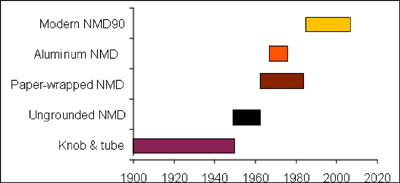EDUCATIONAL MATERIAL
Residential Wiring and Associated Risks
Since the introduction of electricity in homes, circa. 1910, various electrical wiring types have evolved. The primary types can be loosely grouped into five different categories. All wiring types if installed and maintained correctly can be safe. However, if not installed or maintained correctly, each has potential risks.
1910–1950: "Knob and tube"
Knob and tube (K&T) wiring was installed in virtually all houses from 1920 to 1950. It incorporated single conductors run along the sides of the wooden framing. The conductors were supported by ceramic knobs and insulated from contact with wooden joists by ceramic tubes. Electrical splices (wire to wire connections) were done in free air, soldered and covered with insulating tape. The conductors were covered in flame-retardant cloth impregnated with rubber. The conductor quality was excellent, consisting of heavy gauge copper wire with a minimal number of soldered connections enroute to receptacles and lights. However there was no ground conductor. Thus the receptacles of knob-and-tube circuits were not grounded.
Risk in modern homes: The safety concerns of knob-and-tube wiring are due to alterations or modifications of the original wiring.
- UNGROUNDED RECEPTACLES: Original 2-prong ungrounded receptacles have often been exchanged for modern 3-prong receptacles, giving false impression of ground protection.
- POOR CONNECTIONS: To meet the house electrical requirements, circuits are often found tapped to the knob-and-tube, likely done by the homeowner or persons not qualified as residential electricians. These add-on circuits can be most dangerous, resulting in hot-spots at the added connections.
- INSULATION BREAKDOWN: If there has been "overfusing" (overrated fuses or breakers installed on the circuits) there can be insulation breakdown, as overfusing combined with overloading the circuits significantly raises the temperature of the conductors beyond their designed temperature limits, resulting in a fire hazard.
Inspection procedure: At PowerCheck we check all of these above concerns to determine if the wiring is acceptable. Receptacles are inspected to assure that they are the correct type. The quality of the connections is determined by "voltage-drop testing" (an accurate method to determine if there are any poor connections enroute to the receptacles). The panels are checked for any signs of overfusing and the insulation is checked. If any of the above are found to be deficient, the knob-and-tube circuit is not acceptable and repairs are identified.
1950–1962: Ungrounded twin-conductor cable, NMD 1
Twin-conductor cable replaced knob-and tube in early 1950s due to ease of installation. Contained two insulated conductors wrapped in paper and black tar-based cloth casing. Originally contained no ground wire (NMD1), thus the receptacles were not grounded. The insulation temperature rating of this cable was 60°C. Grounded receptacles were not required until 1962.
Risk in modern homes: As with knob-&-tube circuits, original 2-prong ungrounded receptacles have often been exchanged for modern 3-prong receptacles, giving false impression of ground protection. This is an easy check and an easy repair. Ground-fault circuit interruption (GFCI) receptacles or breakers can be installed, providing 3-prong receptacles with ground protection.
1962–1984: Grounded twin-conductor cable, NMD 3 & 6
Ground conductors were required in residential cables in 1962. NMD 3 was introduced containing a ground conductor. Homes were now wired with modern, 3-prong outlets. As with NMD1, NMD3 had an insulation temperature rating of 60°C. Later NMD6 was introduced with an increased temperature rating of 75°C.
Risk in modern homes: Many modern fixtures generate considerable heat inside the enclosure, particularly recessed lighting fixtures (pot light). A number of fires have been reported in these fixtures as a result of cables with low temperature rating. Since 1984 the electrical code requires that all ceiling fixtures be wired with a cable rated at 90°C. Cables rated at 60°C and 75°C are not suitable for modern fixtures. The house should be checked to confirm that these older cables are not used for modern lighting.
1965–1974: Aluminum branch circuit wiring.
Installed in the vast majority of homes during this period. Provided an inexpensive solution to escalated price of copper at that time.
Risk in modern homes: Loose connections where aluminum meets copper have shown to develop over time. This results in very hazardous conditions, which often lead to fire. US Consumer Product Safety Commission reports that aluminum-wired homes are 55 times more likely to have one or more connections reach "Fire Hazard Conditions" than homes wired with copper only. The concern is not the cable, but the aluminum-copper connections.
Inspection procedure: PowerCheck examines the aluminum wiring to determine if the connections are sound. Voltage drop testing is conducted to identify any loose connections that may be present enroute to the receptacle. Once the connections are made safe, an aluminum-wired home can be as safe a home wired with copper.
1984–Present: Modern NMD90 cable
The primary cable used today for the wiring of homes is NMD90 (formerly NMD7). Modern NMD90 cable contains two conductors and a ground enclosed in a PVC jacket. It is an excellent all-round indoor cable suitable for modern lighting. It has an insulation temperature rating of 90°C.
Risk in modern homes: The cable is designed for home wiring in dry locations only. Not designed for outdoor, underground or wet locations. The home should be checked to confirm that it has not been installed in incorrect locations.

The primary types of residential electrical wiring can be
loosely grouped into five different categories.